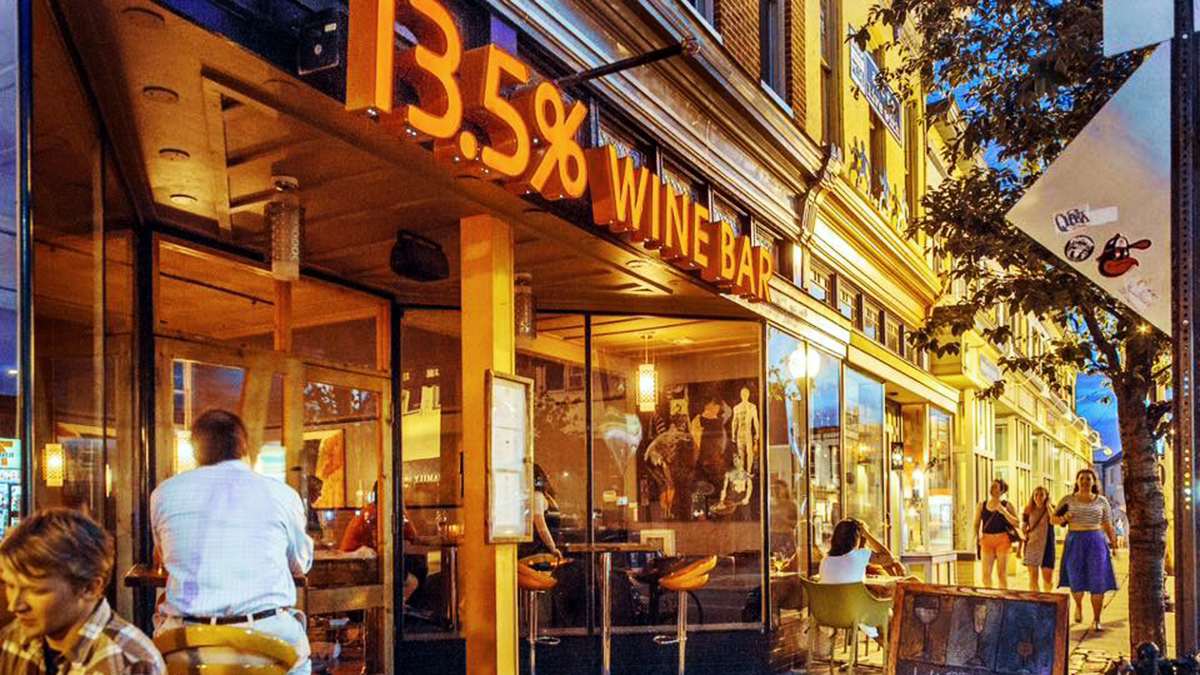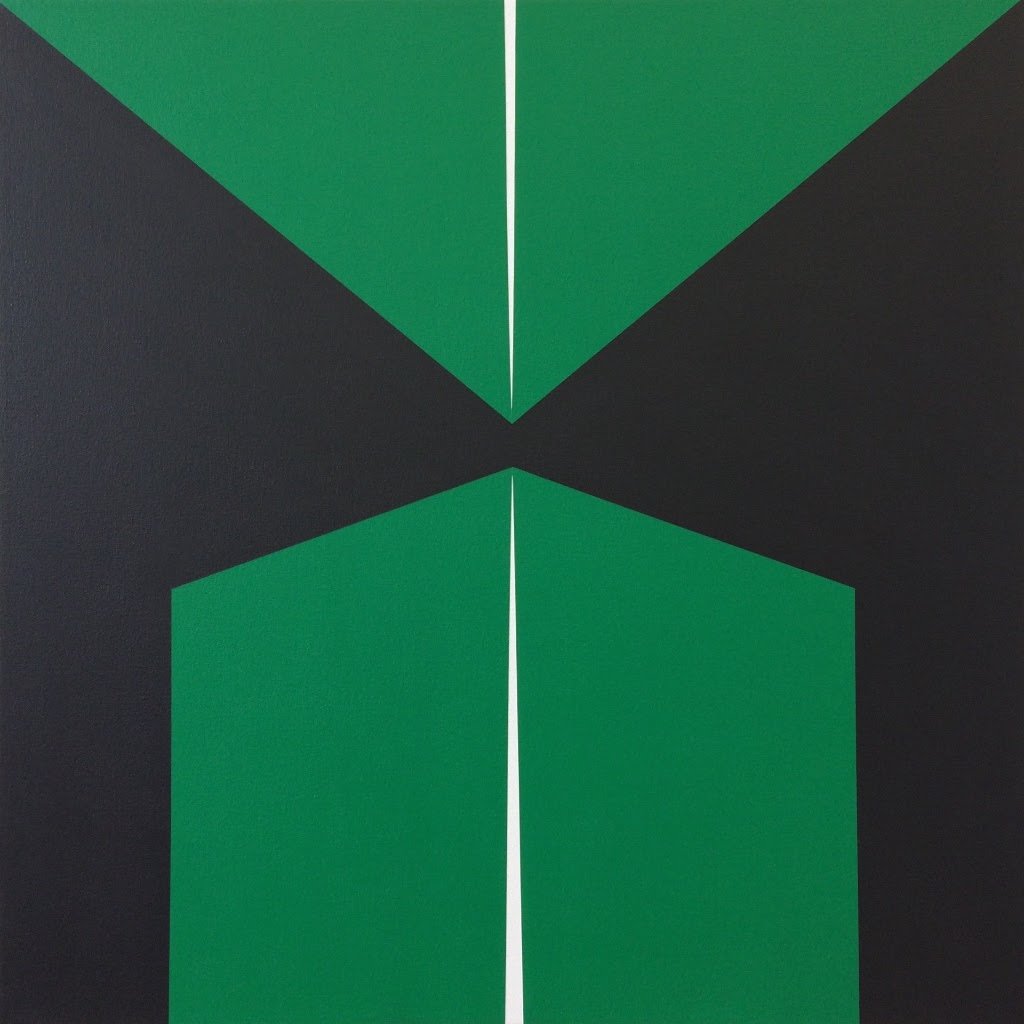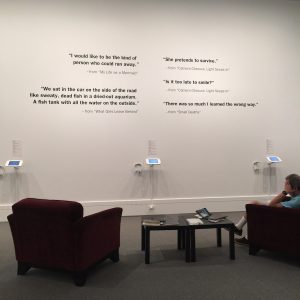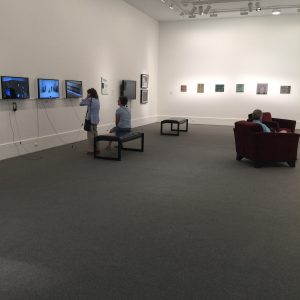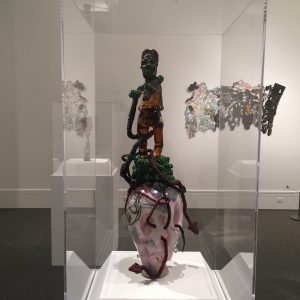The Baker Artist Awards 2016 at the BMA
by Amber Eve Anderson
Given the breadth and quality of work awarded in the 2016 Baker Artist Awards, one would expect the accompanying exhibition at the Baltimore Museum of Art to offer a compelling, rich, and diverse experience. Unfortunately, it barely offers a glimpse into the careers of each of the five artists represented by this year’s prize, struggling to portray contrasting bodies of work, including not only traditional media like painting and sculpture, but also literature, film and performance, which needs to engage with spaces beyond the reach of the museum.
If this is some of the best art Baltimore has to offer, the exhibition makes it hard to see the work for what it is: the culmination of the lives of five ambitious artists pursuing unique crafts. As a viewer, it left me disappointed.
While a museum show is a coveted line on any artist’s resume, it should exist to enhance and expand the work, whereas this exhibit mostly detracts from it. The exhibition space is one large gallery filled with art, yet somehow, still manages to feel empty. Unlike a cohesive group show where works build upon one another and converse in space, the arrangement and placement of most of the pieces in the show sets up unfair contrasts and distractions, lessening the show as a whole.
Cohesively showcasing the work of a sculptor, writer, painter, performer and filmmaker in one physical space would be a challenge for any curator. As the Baker Artist Awards, administered by the Greater Baltimore Cultural Alliance, continue a welcome trend to include not just visual art but literary and performing art, the problem of the exhibit will continue to become more pronounced.
This speaks to the fact that a museum show may not be the best way to culminate the Baker Artist Awards in the first place. The innovative awards and competition website provide a platform for Baltimore area artists to showcase their work in the form of an online portfolio, free of charge. From these sprawling submissions, the winners are selected by secret judges to highlight the talent that Baltimore offers.
However, when the entries span such diverse artistic pursuits, it would be logical to showcase winners in ways specific to their craft. The work of a writer, filmmaker and performer is inhibited by the confines of the pristine pedestals and stark walls of the white cube. Instead, film should be in a black box or theater, performance should be live, and books should be read, part of a library, or heard aloud at a live reading.
 Joyce J. Scott
Joyce J. Scott
Given the Baker’s enthusiasm for and commitment to the arts in Baltimore, a simple solution to the problem of this show would be to tailor a series of smaller events to the needs of each winner. While the intricate work of Joyce J. Scott, $50,000 Mary Sawyers Imboden Prize winner, delightfully fills half of the gallery space at the BMA, the rest of the show is disjointed and bare. Even so, Scott’s work in the show represents only a portion of the sculptures, jewelry, prints, and performances that make up her online portfolio. Furthermore, the museum display pacifies their content and construction with glass vitrines, raised platforms and wire lines stretched between posts, when they require the close examination these barriers inhibit.
Perhaps instead, Scott should have been given more agency in her exhibition to potentially include readings or performances, like she did for the closing reception of The Contemporary’s exhibition Only When It’s Dark Enough Can You See the Stars or her former BMA show, Kickin’ it with the Old Masters in 2000.
 Jen Grow
Jen Grow
For $20,000 Mary Sawyers Baker Prize winner Jen Grow, too, a series of readings throughout the city would be better than the hollow display at the BMA that attempted to activate her ‘area’ in the gallery with large quotes on the walls and comfy reading chair. Or, a copy of her collection of short stories, My Life as a Mermaid, could be donated to every library in the state and be the book of choice for a city-wide summer book club? To read her work is to enter into vividly rendered scenes, the specificity of the sights and smells and sounds of which breathe life into the stories of longing and loss. A museum is not the proper setting for the work of a writer; if they were, bookstores would be more like them.
As part of his award, the work of $5,000 b-grant winner Matt Porterfield’s could be screened at local theaters. “Take What You Can Carry,” a three-channel video piece that portrays a woman navigating different interiors—waking up in the apartment of a lover, taking part in a dance class and getting ready for the day with contemplation—is only one in a series of short and feature-length films. The Baker Artist Awards could even host a series of events showcasing the film and video work of other Baker finalists.
Give b-grant winner and performance artist Naoko Maeshiba the opportunity to present her work in front of a live audience, or hire artists to reenact a selection of her work live in the museum. The two still images and video documentation at the BMA document her purposeful movements on stage with various combinations of objects and projections, but leaves the museum visitor cold and confused, disinterested in understanding more about her work or performance art in general.
Maybe the work of the third b-grant winner Bill Schmidt would be better if the Baker Foundation purchased one of his intimate paintings and donated it to the museum? His quiet abstractions would be better appreciated in a smaller space without ‘louder’ competing bodies of work nearby or in the museum’s contemporary wing, placed in context with other abstract works.
 Bill Schmidt
Bill Schmidt
In addition to the BMA exhibition, each year the Baker Artist Awards also present winners in award’s special on Maryland Public Television showcasing the practice of each winner, but perhaps they could do more to reach the Baltimore community? Other than tailoring the award showcase to the unique needs of each practice, perhaps the Baker Artist Awards could produce an annual publication for the winners rather than an exhibition, or host a series of lectures in which each artist could speak in-depth about their work, or curate fifteen-minute lectures from each artist followed by a reception.
Building on the success of the website, they could transform online space and host a virtual exhibition to draw more attention from beyond Baltimore. Perhaps winners could be asked to choose one of the other 40 Baker Artist Award finalists with whom they could collaborate, exhibit, or lecture; or ask winners to lead workshops at the museum or throughout Baltimore.
While a museum show seems like a forgone conclusion, in this case it’s an option that only highlights the limits of the gallery space. I look forward to the public reception, which will feature live performances, readings and films, but believe it would make more sense to put all of the exhibition efforts into a more thoughtfully designed delivery. There are so many options that could more effectively showcase of the work of such accomplished artists than placing them all together in one room in a museum. At this point I’m not advocating for one over another, just that the artists deserve options as innovative as the work being awarded.
Rather than a months long museum show, I would suggest single weekend or event that highlights the endeavors of these artists engaging in activities that reach beyond the walls of institutions. That is the realm in which the majority of artists operate and in which the reception of their work not only makes sense, but should be encouraged.
*****
Author Amber Eve Anderson is a Baltimore-based multidisciplinary artist whose work uses images, objects and language to explore themes of place and displacement. She is a recent graduate of the Mount Royal School of Art MFA program at MICA.
The Baker Artist Award 2016 exhibit of winners is now on view through September 11 at the Baltimore Museum of Art with a public reception to be held Wednesday, September 7 from 6-9pm.
